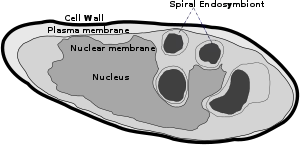Parakaryon myojinensis
 Drawing showing unique cell structure with cell wall, single nuclear membrane, and a single large spiral endosymbiont (seen in section), a combination found neither in prokaryotes nor eukaryotes. Cell is 10 μm long. | |
| Scientific classification | |
|---|---|
| Higher classification: | incertae sedis |
| Genus: | Parakaryon Yamaguchi et al. 2012[1] |
| Species: | P. myojinensis Yamaguchi et al. 2012[1] |

Parakaryon myojinensis, also known as the Myojin parakaryote, is a highly unusual species of single-celled organism known from a single specimen, described in 2012. It has features of both prokaryotes and eukaryotes but is apparently distinct from either group, making it unique among organisms so far discovered.[1] It is the sole species in the genus Parakaryon.
Etymology
The generic name Parakaryon comes from Greek παρά (pará, beside) and κάρυον (káryon, kernel, nucleus), and reflects its distinction from eukaryotes and prokaryotes. The specific name myojinensis reflects the locality where the only sample was collected; from the bristle of a scale worm collected from hydrothermal vents at Myōjin Knoll (明神海丘,[2] 32°06.2′N, 139°52.1′E) 1240 m deep in the Pacific Ocean, near Aogashima island, SE of the Japanese archipelago.[1]
Structure
Parakaryon myojinensis has some structural features unique to eukaryotes, some features unique to prokaryotes, and some features different to both. The table below details these structures, with matching traits coloured beige.[1][3]
| Structure | Prokaryotes | Eukaryotes | Parakaryon myojinensis |
|---|---|---|---|
| Nucleus present | No | Yes | Yes |
| No. of nuclear membrane layers | N/A | 2 | 1 |
| Nuclear pores present | N/A | Yes | No |
| Ribosome location | Cytoplasmic | Cytoplasmic | Cytoplasmic and intranuclear |
| Endosymbionts present | No | Yes | Yes |
| Endoplasmic reticulum present | No | Yes | No |
| Golgi apparatus present | No | Yes | No |
| Mitochondria present | No | Usually | No |
| Chromosome structure | Variable | Linear | Filamentous |
| Cytoskeleton present | Yes | Yes | No |
Classification
It is not clear whether P. myojinensis can be classified as a eukaryote or a prokaryote, the two categories to which all other cellular life belongs. Excluding viruses, which are non-cellular and often distinguished from cellular life, and excluding several fossils that contain disputed evidence of ancient life (nanobacteria, nanobes), P. myojinensis is the only organism to have a completely unknown position in the tree of life. Adding to the difficulties of classification, only one instance of this organism has been discovered to date, and so scientists have been unable to study it further.[1][4]
See also
- Anatoma fujikurai, a species of gastropod discovered at the same location
References
- 1 2 3 4 5 6 Yamaguchi M, Mori Y, Kozuka Y, Okada H, Uematsu K, Tame A, Furukawa H, Maruyama T, Worman CO, Yokoyama K (2012). "Prokaryote or eukaryote? A unique microorganism from the deep sea". J Electron Microsc (Tokyo). 61 (6): 423–431. doi:10.1093/jmicro/dfs062. PMID 23024290.
- ↑ "Fumitoshi MURAKAMI, The Forming Mechanism of the Submarine Caldera on Myojin Knoll in the Northern Part of the Izu-Ogasawara (Bonin) Arc".
- ↑ Evolution of complex life on Earth, take 2
- ↑ Nick Lane (2015). "Epilogue: From the Deep". The Vital Question: Energy, Evolution, and the Origins of Complex Life. W.W.Norton and Company. pp. 281–290. ISBN 978-0-393-08881-6.
Further reading
- Yamaguchi, Masashi; Yamada, Hiroyuki; Chibana, Hiroji (2020-09-25). "Deep-Sea Bacteria Harboring Bacterial Endosymbionts in a Cytoplasm?: 3D Electron Microscopy by Serial Ultrathin Sectioning of Freeze-Substituted Specimen". Cytologia. 85 (3): 209–211. doi:10.1508/cytologia.85.209. S2CID 224920168.
- Yamaguchi M, Yamada H, Uematsu K, Horinouchi Y, Chibana H (2018). "Electron Microscopy and Structome Analysis of Unique Amorphous Bacteria from the Deep Sea in Japan". Cytologia. 83 (3): 336–341. doi:10.1508/cytologia.83.337.
{{cite journal}}: CS1 maint: multiple names: authors list (link)